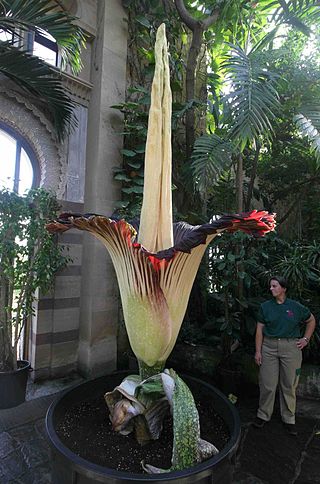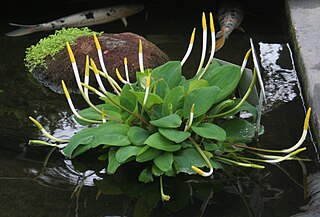
The Araceae are a family of monocotyledonous flowering plants in which flowers are borne on a type of inflorescence called a spadix. The spadix is usually accompanied by, and sometimes partially enclosed in, a spathe. Also known as the arum family, members are often colloquially known as aroids. This family of 114 genera and about 3,750 known species is most diverse in the New World tropics, although also distributed in the Old World tropics and northern temperate regions.

Amorphophallus is a large genus of some 200 tropical and subtropical tuberous herbaceous plants from the Arum family (Araceae), native to Asia, Africa, Australia and various oceanic islands. A few species are edible as "famine foods" after careful preparation to remove irritating chemicals. The genus includes the Titan arum of Indonesia, which has the largest inflorescence of any plant in the genus, and is also known as the 'corpse flower' for the pungent odour it produces during its flowering period, which can take up to seven years of growth before it occurs.

In botany, a spadix is a type of inflorescence having small flowers borne on a fleshy stem. Spadices are typical of the family Araceae, the arums or aroids. The spadix is typically surrounded by a leaf-like curved bract known as a spathe. For example, the "flower" of the well known Anthurium spp. is a typical spadix with a large colorful spathe.

The Hortus botanicus of Leiden is the oldest botanical garden of the Netherlands, and one of the oldest in the world. It is located in the southwestern part of the historical centre of the city, between the Academy building and the old Leiden Observatory building.

Monstera is a genus of 59 species of flowering plants in the arum family, Araceae, native to tropical regions of central and south America.

Carrion flowers, also known as corpse flowers or stinking flowers, are mimetic flowers that emit an odor that smells like rotting flesh. Apart from the scent, carrion flowers often display additional characteristics that contribute to the mimesis of a decaying corpse. These include their specific coloration, the presence of setae, and orifice-like flower architecture. Carrion flowers attract mostly scavenging flies and beetles as pollinators. Some species may trap the insects temporarily to ensure the gathering and transfer of pollen.

Corypha umbraculifera, the talipot palm, is a species of palm native to eastern and southern India and Sri Lanka. It is also grown in Cambodia, Myanmar, Thailand, Mauritius and the Andaman Islands. It is one of the five accepted species in the genus Corypha. It is a flowering plant with the largest inflorescence in the world. It lives up to 60 years before bearing flowers and fruits. It dies shortly after.

Dracontium is a genus of flowering plants similar to those of Amorphophallus. Unlike Amorphophallus which is found in the Old World, this genus has a New World distribution and is native to South America, Central America, southern Mexico, and the West Indies.

Orontium aquaticum, sometimes called golden-club, floating arum, never-wets or tawkin, is a species of flowering plants in the family Araceae. It is the single living species in the genus Orontium, which also contains several extinct species described from fossils. O. aquaticum is endemic to the eastern United States and is found growing in ponds, streams, and shallow lakes. It prefers an acidic environment. The leaves are pointed and oval with a water repellent surface. The inflorescence is most notable for having an extremely small almost indistinguishable sheath surrounding the spadix. Very early in the flowering this green sheath withers away leaving only the spadix.

Holochlamys is a monotypic genus of flowering plants in the family Araceae. Holochlamys beccarii is the only species in the genus Holochlamys. It is native to New Guinea and the Bismarck Archipelago and is found growing in mud near lowland streams or rocky streambeds at high elevations.

Thaumatophyllum bipinnatifidum is a plant in the genus Thaumatophyllum, in the family Araceae. Previously it was classified in the genus Philodendron within subgenus Meconostigma. The commonly used names Philodendron bipinnatifidum and Philodendron selloanum are synonyms. This plant is native to South America, namely to Brazil, Bolivia, Argentina, and Paraguay, but is also cultivated as a landscape plant in tropical, subtropical and warm temperate climates.

Amorphophallus titanum, the titan arum, is a flowering plant in the family Araceae. It has a large unbranched inflorescence; a tall single leaf, branched like a tree; and a heavy tuber which enables the plant to produce the inflorescence. A. titanum is endemic to rainforests on the Indonesian island of Sumatra.

Montrichardia arborescens, the yautia madera, or moco-moco, is a tropical plant grows along river banks, swamps, or creeks to a maximum height of 9'. They consist of arrow shaped leaves that are food sources for animal species. The plant produces inflorescences which then leave a fruit of Montrichardia arborescens which is edible and can be cooked. Its fruiting spadices produces large infructescences, which contain about 80 edible yellow fruits.
Alocasia robusta is a gigantic herb of the arum family (Araceae) which is endemic to the island of Borneo. The plant is a rosette herb consisting of several very large leaves having a sagittate lamina or blade up to twelve feet long by eight feet wide, borne on very stout petioles or stalks up to 12 feet in length. More recently, Anthony Lamb of the Sabah Agricultural Department found and measured one individual with a lamina fifteen feet in length., the largest leaf of any non-palm. The inflorescence is the spathe and spadix typical of the Arum family, with the spathe being a very dark blackish-purple color. This species was unknown to science prior to 1967. The plant is usually trunkless.

Anthurium wendlingeri is a species of aroid plant, in the genus Anthurium, found from Central to South America, from SE Nicaragua to NW Colombia. It grows in moist, montane tropical habitats as an epiphyte. Unique among its genus, A. wendlingeri has long, pendant and strap-like leaves, and can have a slightly velvety appearance.

Dracontium gigas is an herbaceous rainforest plant of the calla family (Araceae), native to Central America. It resembles the Old World species Amorphophallus titanum but has a spadix that is shorter than the spathe, with a somewhat smaller inflorescence up to 34 in (86 cm) in height. The leaf is up to 11.5 ft (3.5 m) high by up to 8 ft (2.4 m) wide. The petiole of A. titanum can be 12 or more inches thick, but that of D. gigas is only 2 to 3 inches in thickness.
Amorphophallus hewittii is geophytic aroid of family Araceae.

Anthurium salvinii, commonly known as bird's nest anthurium or tabacon, is a species of herbaceous epiphyte, in the genus Anthurium. Native from southern Mexico, Costa Rica, Honduras, Guatemala, Nicaragua, Panama through to Colombia.




















